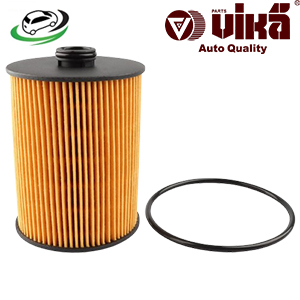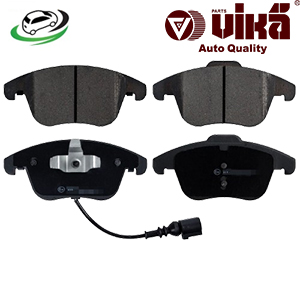-48%
Get Stabiliser mounting AUDI A2 2000-2005/VW Polo IV 6Q0411314L
Stabilizer mounting, also known as sway bar mounting or anti-roll bar mounting, is a crucial component of a vehicle’s suspension system. The stabilizer bar (sway bar or anti-roll bar) helps to reduce body roll during cornering and improve vehicle stability. The mounting of this stabilizer bar plays a vital role in ensuring its proper function. This guide will delve into the components, functions, types, benefits, symptoms of faulty mounting, and maintenance practices of stabilizer mounting in automobiles.
Components of Stabilizer Mounting
- Stabilizer Bar: A metal bar that connects the left and right sides of the suspension system. It helps to maintain the vehicle’s balance by resisting body roll.
- Bushings: These are made of rubber or polyurethane and fit around the stabilizer bar, providing cushioning and reducing noise. They allow the stabilizer bar to flex while keeping it securely in place.
- Mounting Brackets: Metal brackets that hold the bushings and attach the stabilizer bar to the vehicle’s chassis or frame.
- Links (End Links): These connect the ends of the stabilizer bar to the suspension components (such as control arms or struts), allowing for movement and flexibility.
Function of Stabilizer Mounting
Stabilizer mounting ensures that the stabilizer bar is securely attached to the vehicle’s frame and suspension components. It allows the stabilizer bar to perform its function of reducing body roll and enhancing stability during turns. The mounting components (bushings, brackets, and links) provide the necessary flexibility and cushioning, allowing the stabilizer bar to move and flex as needed without causing excessive noise or wear.
Types of Stabilizer Mounting
- Rubber Bushings: Commonly used in standard vehicles, rubber bushings provide good cushioning and noise reduction but may wear out faster than other materials.
- Polyurethane Bushings: More durable and resistant to wear and tear, polyurethane bushings offer better performance for high-stress applications, such as performance or off-road vehicles.
- Adjustable Links: These links allow for adjustments in the length of the stabilizer bar, which can be useful for fine-tuning the suspension setup in performance or custom applications.
- Standard Links: Fixed-length links that provide a solid connection between the stabilizer bar and the suspension components.
Benefits of Proper Stabilizer Mounting
1. Improved Handling and Stability
Benefit: Proper stabilizer mounting ensures that the stabilizer bar effectively reduces body roll during cornering.
Explanation: The stabilizer bar connects the left and right sides of the suspension, distributing forces evenly and reducing the vehicle’s tendency to lean during turns. This leads to improved handling and more precise control of the vehicle.
2. Enhanced Safety
Benefit: Reduced body roll and improved stability increase the overall safety of the vehicle.
Explanation: By keeping the vehicle more level during turns, proper stabilizer mounting helps maintain better tire contact with the road, improving traction and reducing the risk of rollover accidents. This is particularly important during emergency maneuvers and high-speed driving.
3. Increased Ride Comfort
Benefit: Properly mounted stabilizer bars and high-quality bushings reduce vibrations and noise.
Explanation: The bushings and other mounting components cushion the stabilizer bar, preventing it from transferring excessive vibrations and noise to the vehicle’s chassis. This results in a smoother and quieter ride, enhancing overall driving comfort.
4. Longevity of Suspension Components
Benefit: Proper stabilizer mounting reduces wear and tear on other suspension components.
Explanation: By evenly distributing forces and minimizing excessive movement, a well-mounted stabilizer bar prevents undue stress on the suspension system. This can extend the life of components such as shocks, struts, control arms, and tires, reducing maintenance costs.
5. Consistent Performance in Various Driving Conditions
Benefit: Vehicles with properly mounted stabilizer bars perform consistently in different driving conditions, including rough roads, sharp turns, and varying speeds.
Explanation: The stabilizer bar helps maintain the vehicle’s balance and stability across a range of driving scenarios. Proper mounting ensures that the bar can flex and react appropriately, providing consistent performance regardless of road conditions.
6. Better Steering Response
Benefit: Proper stabilizer mounting improves steering response and accuracy.
Explanation: A securely mounted stabilizer bar helps keep the vehicle’s wheels aligned and reduces body roll, leading to more predictable and responsive steering. This makes the vehicle easier to control and more enjoyable to drive.
7. Enhanced Tire Performance and Lifespan
Benefit: Proper stabilizer mounting contributes to even tire wear and extended tire life.
Explanation: By maintaining proper suspension alignment and reducing excessive movement, a well-functioning stabilizer bar prevents uneven tire wear. This not only improves the performance and safety of the tires but also extends their lifespan, saving on replacement costs.
8. Reduced Risk of Suspension Damage
Benefit: Proper stabilizer mounting minimizes the risk of damaging other suspension components.
Explanation: Faulty or loose stabilizer mounting can lead to excessive movement and stress on the suspension system, potentially causing damage to shocks, struts, and other components. Proper mounting prevents these issues, preserving the integrity of the suspension system.
9. Optimized Performance for Modified Vehicles
Benefit: For vehicles with performance upgrades or modifications, proper stabilizer mounting is essential for optimal performance.
Explanation: Performance vehicles often have stiffer suspension setups and may experience higher forces during driving. Properly mounted and possibly upgraded stabilizer bars and components ensure that these vehicles maintain their intended performance characteristics and handle increased stress effectively.
10. Prevention of Costly Repairs
Benefit: Maintaining proper stabilizer mounting can prevent costly repairs associated with suspension damage and excessive wear.
Explanation: Regular inspections and maintenance of stabilizer mounting components can catch issues early before they lead to significant damage. This proactive approach reduces the likelihood of expensive repairs and extends the overall lifespan of the vehicle’s suspension system.
Symptoms of Faulty Stabilizer Mounting
1. Clunking or Rattling Noises
Symptom: You may hear clunking, rattling, or knocking noises coming from the suspension area, especially when driving over bumps, potholes, or uneven surfaces, and during turns.
Cause: Worn or damaged bushings, loose or broken mounting brackets, or worn links can cause the stabilizer bar to move excessively and hit other suspension components, producing noise.
Consequence: Ignoring these noises can lead to further damage to the suspension system and negatively affect vehicle handling.
2. Poor Handling and Increased Body Roll
Symptom: The vehicle may exhibit increased body roll when cornering, feel less stable, and have a loose or floating sensation during turns. You might also notice a decrease in handling performance.
Cause: Faulty stabilizer mounting can prevent the stabilizer bar from effectively reducing body roll, leading to a less stable and more difficult-to-control vehicle.
Consequence: Reduced handling and stability can increase the risk of losing control of the vehicle, especially in emergency maneuvers or on winding roads.
3. Uneven Tire Wear
Symptom: You may observe uneven tire wear, where one side of the tires wears out more quickly than the other.
Cause: Improperly mounted stabilizer bars can cause misalignment in the suspension system, leading to uneven distribution of forces on the tires and premature wear.
Consequence: Uneven tire wear can reduce the lifespan of your tires, increase the risk of blowouts, and negatively affect vehicle handling and safety.
4. Steering Issues
Symptom: The steering may feel loose, less responsive, or have increased play, making it more difficult to maintain a straight line or control the vehicle during turns.
Cause: Faulty stabilizer mounting can affect the suspension geometry and alignment, leading to changes in the steering response.
Consequence: Poor steering response can make driving more challenging and increase the risk of accidents, especially in emergency situations.
5. Vehicle Leaning to One Side
Symptom: The vehicle may lean or sag to one side, especially during turns or when parked on a level surface.
Cause: A broken or disconnected stabilizer bar or mounting component can cause uneven distribution of weight and forces in the suspension system, leading to leaning.
Consequence: A leaning vehicle can be difficult to control and may indicate more severe suspension issues that need immediate attention.
6. Excessive Swaying
Symptom: The vehicle may sway excessively from side to side, particularly in windy conditions or when making quick lane changes.
Cause: Faulty stabilizer mounting can reduce the stabilizer bar’s effectiveness in controlling lateral movement, leading to excessive swaying.
Consequence: Excessive swaying can make the vehicle feel unstable and increase the risk of losing control, particularly at higher speeds.
7. Visible Wear or Damage
Symptom: Upon visual inspection, you may notice cracked, split, or worn bushings, loose or damaged mounting brackets, or worn links.
Cause: Regular wear and tear, exposure to harsh conditions, or impact damage can cause visible deterioration of stabilizer mounting components.
Consequence: Visible damage is a clear indicator that the stabilizer mounting components need to be replaced to restore proper suspension function and vehicle stability.
8. Increased Noise During Cornering
Symptom: You may hear increased noise, such as creaking or groaning, specifically when taking corners or making sharp turns.
Cause: Worn or damaged stabilizer mounting components can cause the stabilizer bar to flex improperly, leading to increased noise during cornering.
Consequence: Ignoring these noises can result in further wear and potential failure of the stabilizer bar and associated components.
Maintenance of Stabilizer Mounting
- Regular Inspection: Periodically inspect the stabilizer bar, bushings, brackets, and links for signs of wear, damage, or looseness. Pay attention to any unusual noises or handling issues.
- Replace Worn Components: Replace worn or damaged bushings, brackets, and links as needed. Using high-quality replacement parts can improve performance and longevity.
- Lubrication: Some bushings may benefit from periodic lubrication to reduce noise and wear. Check the manufacturer’s recommendations for the type of bushing used in your vehicle.
- Tightening Brackets: Ensure that all mounting brackets are securely fastened. Loose brackets can cause noise and reduce the effectiveness of the stabilizer bar.
- Professional Alignment: After replacing or adjusting stabilizer mounting components, have the vehicle’s alignment checked and adjusted by a professional to ensure proper suspension geometry and handling.
Follow us on Facebook for more parts.





